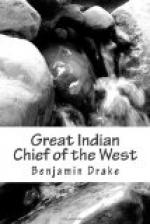“After several rounds of dancing, and of striking at the post, by the warriors, Mi-a-ke-ta, or The Little Soldier, a war-worn veteran, took his turn to strike the post. He leaped actively about, and strained his voice to its utmost pitch, whilst he portrayed some of the scenes of blood in which he had acted. He had struck dead bodies of individuals of all the Red nations around; Osages, Konzas, Pawnee Loups, Pawnee Republicans, Grand Pawnees, Puncas, Omawhaws, Sioux, Padoucas, La Plain, or Bald heads, Ietans, Sacs, Foxes, and Ioways. He had struck eight of one nation, seven of another, &c.
“He was proceeding with his account, when Ietan ran up to him, put his hand upon his mouth, and respectfully led him to his seat. This act was no trifling compliment to the well-known brave; it indicated, that he had so many glorious achievements to speak of, that he would occupy so much time, as to prevent others from speaking; and, moreover, put to shame the other warriors, by the contrast of his actions with theirs.
“Their physical action in dancing is principally confined to leaping a small distance from the ground, with both feet, the body being slightly inclined, and, upon alighting, an additional slight but sudden inclination of the body is made, so as to appear like a succession of jerks; or the feet are raised alternately, the motion of the body being the same. Such are the movements in which the whole party correspond; but, in the figures—as they are termed in our assembly rooms—each individual performs a separate part, and each part is a significant pantomimic narrative. In all their variety of action, they are careful to observe the musical cadences. In this dance, Ietan represented one who was in the act of stealing horses; he carried a whip in his hand as did a considerable number of the Indians, and around his neck were thrown several leathern thongs, for bridles and halters, the ends of which trailed upon the ground behind him. After many preparatory manoeuvres, he stooped down, and with his knife, represented the act of cutting the hopples of horses. He then rode his tomahawk, as children ride their broomsticks, making use of his whip, as to indicate the necessity of rapid movement, lest his foes should overtake him. Wa-sa-ha-jing-ga, or Little Black Bear, after a variety of gestures, threw several arrows in succession, over his own head—thereby indicating his familiarity with the flight of such missiles. He, at the same time, covered his eyes with his hand, to indicate that he was blind to danger. Others represented their manoeuvres in battles, seeking their enemy, discharging at him their guns or arrows, &c. &c.




